In the last issue I discussed how bad weather made me give up my plan to harvest tomatoes for an extra long-term cultivation and switch to growing cucumbers, as well as the progress of the no-till continuous cultivation methods, which utilizes the perennial grass biomass as it is. The bad weather continued in April, and as the newspaper article on the below shows, the amount of rain was double that of an average year, and the area where I planted cucumbers was flooded several times. Normally, downy mildew would occur frequently, I used the EM fermented green waste liquid introduced in the 181st issue each time and also applied an activated mix of a 1:1000 dilution of molasses and EM-3 (phototrophic bacteria), and injected it between the plants once a week, the hado effect of EM gravitron charcoal was enhanced even further, no disease occurred at all, and the plants grew as shown in photos 1 and 2 below.
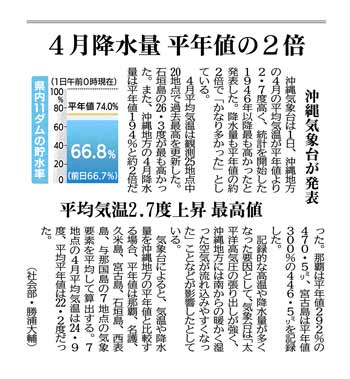
Courtesy of Okinawa Times 5/2/2024
Announced by Okinawa Meteorological Observatory
Average Temperature Increased by 2.7 Degrees Celsius to Record High
The Okinawa Meteorological Observatory announced on April 1st that the average temperature in April in the Okinawa region was 2.7 degrees higher than normal, the highest since 1946, when they first began keeping statistics. The amount of precipitation was also “considerably higher,” at about twice the normal level. The average temperature in April reached a record high at 20 out of 25 observation points. Ishigaki Island had the highest temperature at 26.3 degrees Celsius. April precipitation in the Okinawa region was 194% of the average. The average precipitation in April in the Okinawa region was 194%, about twice the average value. Naha recorded 470.5 mm, 292% of the normal amount, and Miyakojima recorded 446.5 mm, 300% of the normal amount.
The Okinawa Meteorological Observatory attributed the record high temperatures and precipitation the “strongly protruding Pacific high-pressure system, making it easier for warm, humid air to flow into the Okinawa region from the south.”
According to the Okinawa Meteorological Observatory, when comparing temperature and precipitation to the normal values in the Okinawa region, the normal values are calculated by averaging weather elements from seven locations: Naha, Nago, Kumejima, Miyakojima Ishigakijima, Iriomotejima, and Yonagunijima. The average temperature in April at the seven sites was 24.9℃, compared to the average normal temperature of 22.2 ℃.
(Reported by Daisuke Katsuura, Social Affairs Department)
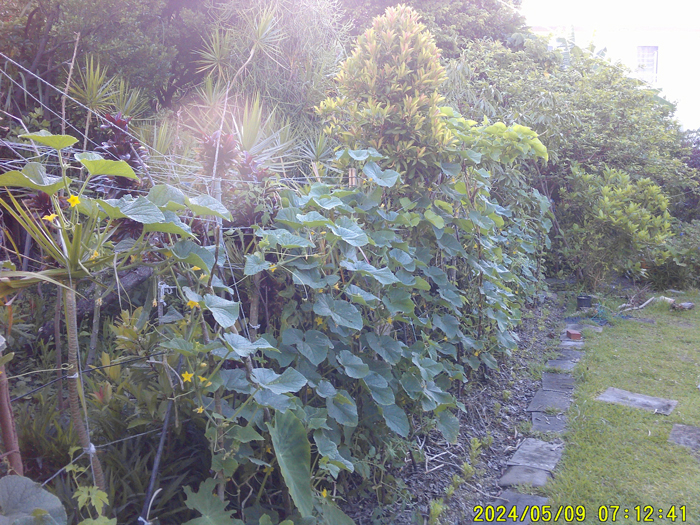
Photo1
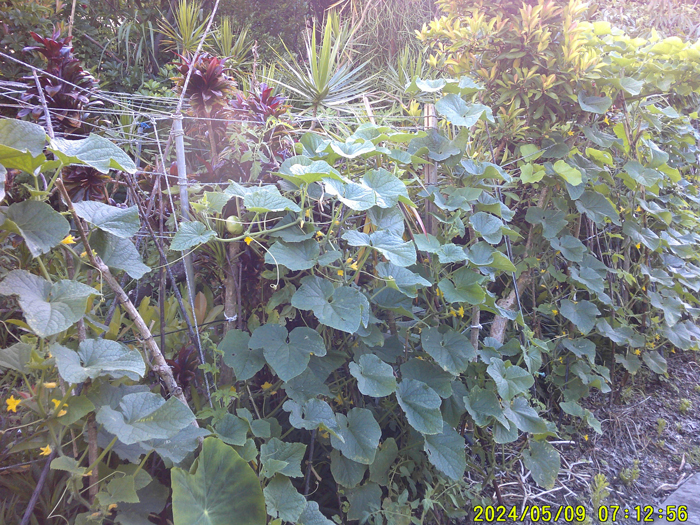
Photo2
At the same time, a number of multiple female flowers appeared on a single section, symbolic of the phenomenon of limit breakthrough. Generally, even if multiple female flowers bloom and the first fruit can be harvested, the remaining female flowers will often end up misshapen, so it is generally believed that there is little point in multiple female flowers blooming. However, as long as the fertilizer does not run out in EM cultivation, the female flowers can also be harvested one after another (Photos 3,4 and 5)

Photo 3-5
This time, I took the precautionary measure of using 50 g of EM long-term fermented chicken manure to fertilize each square meter, (50 kg per 10 are). Photo 6 shows the first fruits on the bottom row. Although the fruits are usually thinned out, the fruits are normal, the plants are vigorous, and many side branches have appeared. Photo 7 shows the cucumbers harvested from the second row and bitter melons from my home garden.
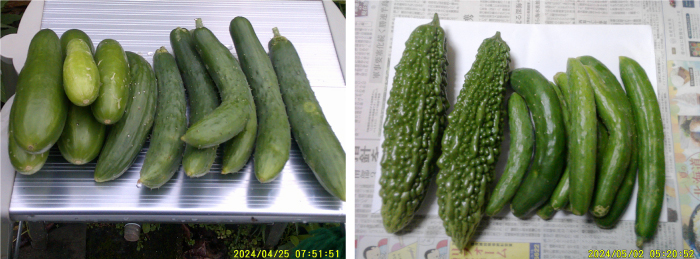
Photo 6,7
I had stopped harvesting bananas after the typhoon at the end of last August, but have begun to harvest them again, as seen in Photo 8.
I extended the time until harvest by 15 days or more, and the bananas are as full as summer fruits. Salt was the only fertilizer I used. The Spathiphyllum (peace lilies) under the guava trees are blooming beautifully as usual, and virus damage has decreased considerably. See Photo 9.
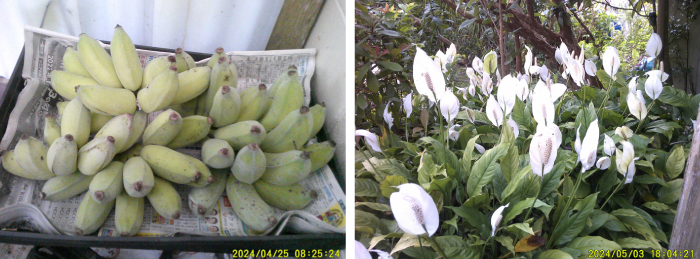
Photo 8,9
The number of flowers has increased and they are blooming so vigorously they look like different varieties. Bulbs in particular are becoming healthier each year, and unusual varieties are beginning to appear.

Photo: Wild papayas are bearing an abundant amount of fruit at the edge of Mt. Mansedake forest behind the Okinawa Prefectural Youth Center in Ishigaki City.
Near the Okinawa Prefectural Youth Center in Ishigaki
A rough count shows nearly 50 papayas. Native papayas are often seen growing wild in the mountain forests of Ishigaki Island, and are known to be much better tasting than the foreign papayas sold in supermarkets. These are small evergreen trees native to South America, believed to have been brought to Okinawa during the Ryukyu Dynasty. There are both male and female plants, 4 to 5 meters tall, with the female plants bearing fruit. The green fruit is usually eaten as a chanpuru dish, and when they ripen and turn yellow, they are eaten as fruit. In Yaejima, they are called “Manjumai”.
(Reported by Hidekazu Haebaru)
(Courtesy of Okinawa Times 2/25/2024)
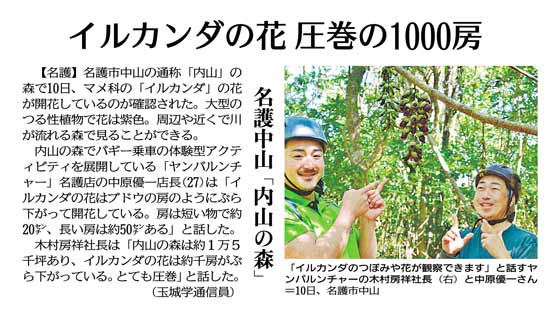
Photo: “You can observe the buds and flowers of the Irukanda,” said Fusayoshi Kimura (right), president of Yanbalucha, with Yuichi Nakahara, on March 10th in Nakayama, Nago City.
On March10th, flowers of the Irukanda (Fabaceae), were found blooming in the forest commonly known as “Uchiyama” in Nakayama, Nago City. They are large climbing plants with purple flowers. We can find them in the surrounding areas and in forests where rivers flow.
Yuichi Nakahara, 27, manager of the Nago branch of “Yambaluncha,” which offers hands-on activities such as dune buggy rides in the Uchiyama forest, said, “Irukanda flowers hang down like clusters of grapes. The shortest clusters are about 20 centimeters long, and the longest ones are about 50 centimeters long.”
President Fusayoshi Kimura said, “The Uchiyama forest is about 533,700 sq ft and there are about 1,000 bunches of Irukanda flowers hanging down there. It’s a most impressive sight.”
(Reported by Manabu Tamaki)
(Courtesy of Okinawa Times 3/21/2024)
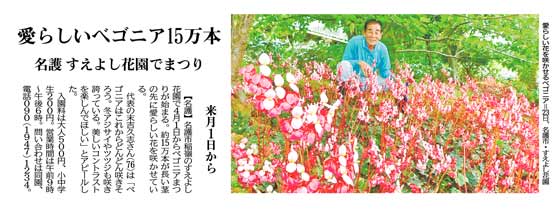
Photo: Lovely begonias in full bloom at the Sueyoshi Flower Garden in Nago City on March 23rd.
Festival starts on April 1 at the Sueyoshi Flower Garden in Nago City, Okinawa.
The Begonia Festival will start on April 1st at the Sueyoshi Flower Garden in Inamine, Nago City, Okinawa Prefecture. About 150,000 begonias are blooming now, with lovely flowers gracing the end of their long stems.
Mr. Hisashi Sueyoshi, 76, the representative of the festival, said, “Begonias will be in full bloom from now on. Winter hydrangeas and azaleas are also in full bloom. I hope you will enjoy the beautiful contrast.”
Admission is 500 yen for adults and 200 yen for elementary and junior high school students. The festival is open from 9 am to 6:00 pm. For inquiries, please call the park at 090 (1947)1234.
(Courtesy of Okinawa Times 3/29/2024)
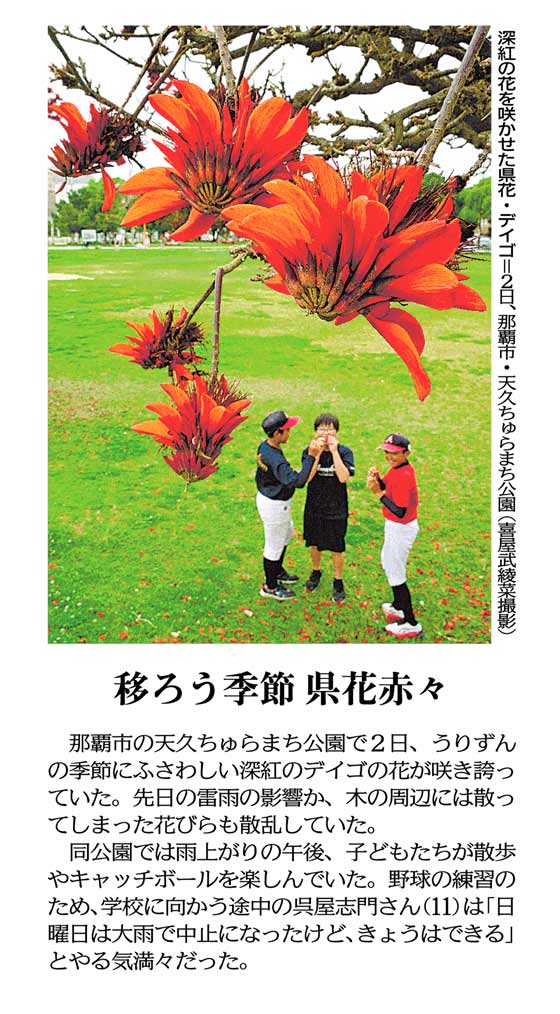
Photo: The deep red blossoms of the Okinawa Prefectural flower at Ameku Chura Town Park in Naha City on April 2nd (Photo by Ayana Kyan)
On April 2nd, the crimson Deigo (coral tree) flowers, a fitting flower for the Urizun season (March to April), were in full bloom at Ameku Chura Town Park in Naha City. Perhaps due to the recent thunderstorm, petals were scattered around the trees. In the park, children were enjoying walks and playing catch on the afternoon after the rain. Shimon Goya, 11, on his way to school for baseball practice, was full of enthusiasm, commenting that “Our practice was cancelled due to heavy rain on Sunday, but we can play today.”
(Courtesy of Okinawa Times 4/3/2024)
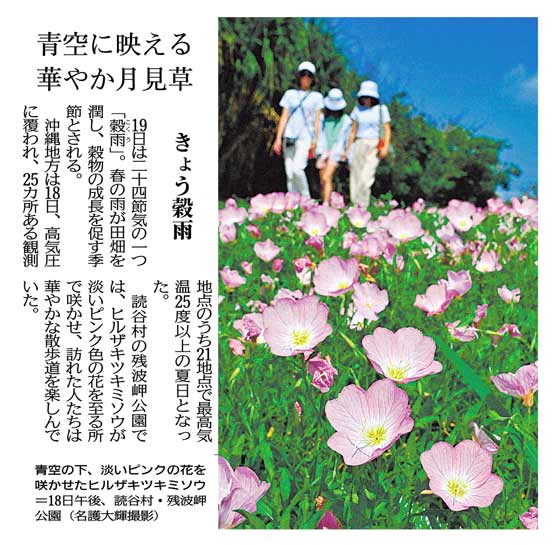
Photo: Light pink flowers of evening primroses under a blue sky at Cape Zanpa Park in Yomitan Village
April 19th is “Kokuu (Grain Rain),” one of the 24 solar terms. It is said to be the season when spring rains moisten the fields and promote the growth of grain. On April 18th, Okinawa was covered by a high pressure system, and 21 of the 25 observation sites recording summer-like temperatures, with a maximum temperature of over 25 degrees Celsius. At Cape Zanpa Park in Yomitan Village, Pink evening primroses were blooming everywhere with light pink flowers under a blue sky, and visitors enjoyed the colorful walkway.
(Photo by Daiki Nago)
(Courtesy of Okinawa Times 4/19/2024)
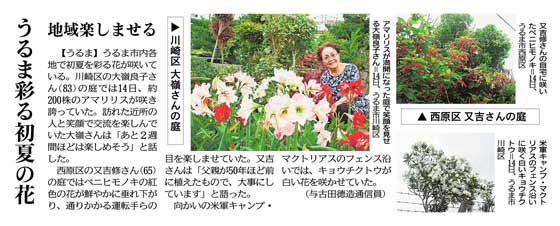
Photo: Yoshiko Omine smiling in her garden where amaryllis are in full bloom in Kawasaki-ku, Uruma City, on April 14th. Photo: Red flowers of Acalypha hispida, blooming at Osamu Matayoshi’s house, Nishihara-ku, Uruma City on April 14th. Photo: White oleanders blooming along the fence of U.S. military Camp McTureous, Kawasaki-ku, Uruma City on April 14th.
Enjoying the Local Community Flowers are blooming in early summer all over Uruma City. On April 14th, about 200 amaryllis plants were in full bloom in the garden of Ms. Yoshiko Omine (83) of Kawasaki-ku. Ms. Omine, who was smiling and enjoying being with her neighbors who were visiting her, said, “I think we will be able to enjoy the amaryllis for about two more weeks.” In the garden of Mr. Osamu Matayoshi (65) of Nishihara-ku, the red flowers of the Acalypha hispida hung down brightly, delighting the eyes of passing drivers. Mr. Matayoshi said, “My father planted it about 50 years ago, and I really cherish it.” Along the fence of the U.S. military Camp McTureous across the street, white oleander flowers were in full bloom.
(Reported by Tokuzo Yokota)
(Courtesy of Okinawa Times 4/20/2024)
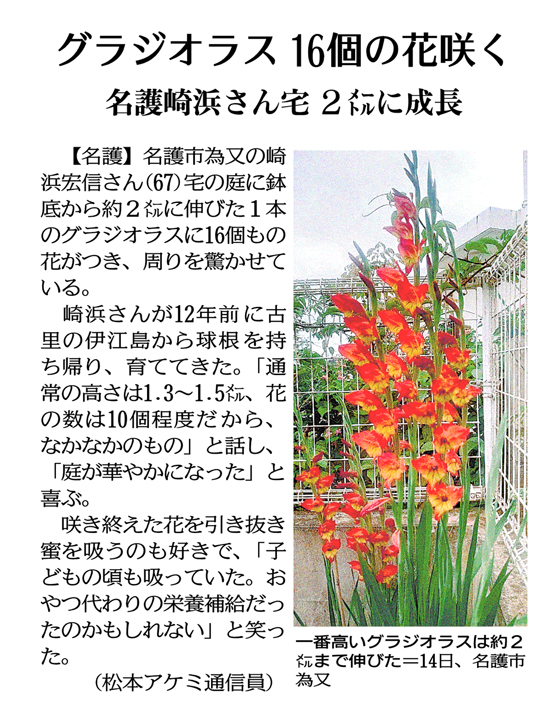
Photo: The tallest gladiolus has grown to about two meters, on April 14th, Biimata, Nago City.
Has grown to 2 meters at Mr. Sakihama’s house in Nago City
A single gladiolus plant that has grown about two meters from the bottom of a pot in the garden of Mr. Hironobu Sakihama (67) of Biimata, Nago City, has 16 flowers, surprising everyone around him. Mr. Sakihama brought the bulbs back from his hometown on Iejima twelve years ago and has been growing them ever since. “They usually grow to about 1.3 to 1.5 meters in height and have about 10 flowers, so this one is especially impressive. It has made my garden more colorful.” He also likes to pluck out the flowers that have finished blooming and suck the nectar. “I used to suck them when I was a child, too. Maybe it was a way to get nutrition instead of having snacks,” he said, laughing.
(Reported by Akemi Matsumoto)
(Courtesy of Okinawa Times 4/23/2024)
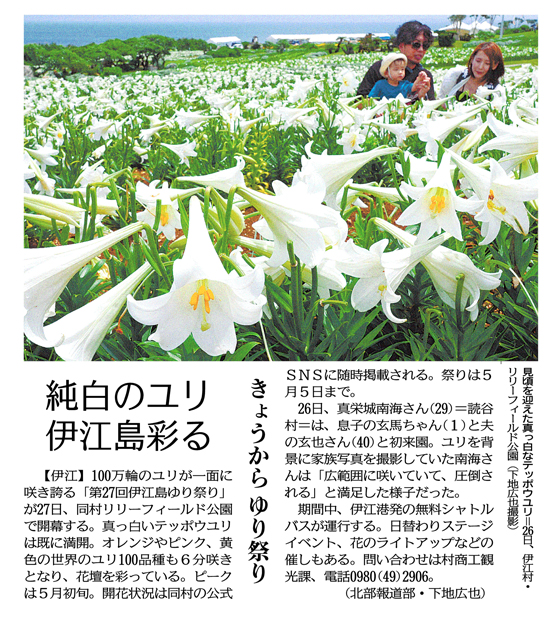
Photo: Pure white Easter lilies at their best on March 26th at Lily Field Park in Ie Village. (Photo by Hironari Shimoji)
Lily Festival starts today
The 27th Ie Island Lily Festival, where one million lilies are in full bloom, will open on the 27th at Lily Field Park in Ie Village, Okinawa Prefecture. The pure white Easter Lilies are already in full bloom, and 100 varieties of orange, pink and yellow lilies from around the world are also 60% in bloom, decorating the flower beds. The peak of the blooming season will be in early May. The blooming status will be posted on the village’s official SNS from time to time. The festival will last until May 5th.
On May 26th, Mrs. Minami Maeshito (29) from Yomitan Village visited the park for the first time with her son Genma (1) and her husband Genya (40). Mrs. Maeshiro, who was taking family photos with the lilies in the background, loved what she saw at the park, saying, “I’m overwhelmed by the wide range of blooms.”
During the festival, free shuttle bus service will be available from Ie Port. There will also be daily stage presentations, flower illuminations, and other events. For inquiries, please contact the Village Commerce, Industry and Tourism Division. Phone number is 0980(49)2906.
(Reported by Hironari Shimoji, Northen Division News)
(Courtesy of Okinawa Times 4/27/2024)
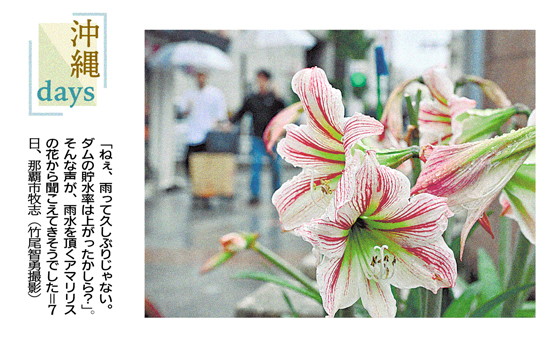
Photo: “Hey, it’s been a while since we’ve had rain. I wonder if the dam’s reservoir level has gone up?” One could almost hear the voices of the amaryllis flowers as they received the welcome rainwater. April 7th, Makishi, Naha City.
(Photo by Chiyu Takeo)
(Courtesy of Okinawa Times 4/25/2024)
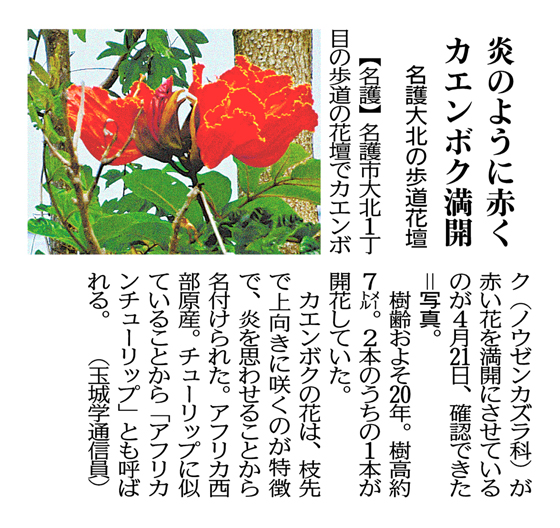
Photo: On April 21st, I spotted the red blossoms of a Kaenboku (Bignoniaceae), in full bloom in a flower bed on the sidewalk of Okita 1-chome, Nago City.
Kaenboku (African Tulips) in full bloom
A Sidewalk Flower Bed in Okita, Nago City
Read the original Japanese message at the link below.
2024.6.1 Updated.